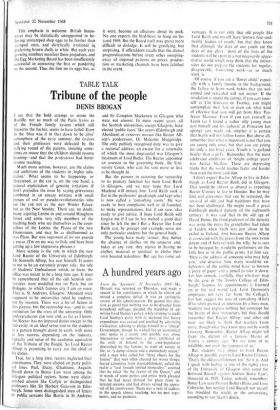Scrambled eggs
CONSUMING INTEREST LESLIE ADRIAN
The annual general meeting of 'registered pro- ducers' under the egg marketing scheme is due to be held in Knightsbridge on 3 December. Given the size of the council chamber at Agriculture House, it seems intrinsically im- probable that all 194,000 of them or even the 40 per cent who actually sell eggs to the pro- ducer marketing board, will turn up. If they did, of course, the Albert Hall couldn't begin to cope. Yet the whole future of the scheme and of the industry are at present in the melting pot (or frying pan), and the big question that hangs over this twelfth AGM is whether there is ever going to be a thirteenth.
`It is expected,' says the yolk-coloured, lion- stamped document circulated in advance, 'that by the time this annual report is published the Minister of Agriculture, Fisheries and Food will have announced his decisions on the future of egg production and marketing.' As the gentleman in question was imprudent enough to indicate way back in July that he hoped to reach these decisions by the autumn, the British Egg Marketing Board can plead not guilty to wishful thinking. But so far Mr Cledwyn Hughes has shown a disposition to speak about almost every indigenous product except eggs, and was recently accused by two agricultural economists at the poultry industry conference of temporising for political pur- poses.
Perhaps he is. However, since eggs have been politically scrambled according to one recipe or another for well-nigh forty years, it is hard to withhold sympathy from those now called upon to unscramble them. The nature of their problem may be apprehended in the story of Dean Swift, who, confronted one mealtime with an intolerably over-roasted piece of meat, purred at his terrorised serving-girl, 'Sweetheart, kindly take this down into the kitchen and do it less.' To do it less is, in essence, the advice given the Government by its egg marketing re- organisation commission. But for consumer and producer alike, the British egg has somewhat greater social and economic significance than a dead egghead's dinner.
In the Olympic egg-and-spoon race, it is true, Britain does not yet qualify for a bronze. Israel, the United States and. New Zealand (in that order) eat more eggs than we do. But 269 per head per annum is scarcely bad going, and their cost represents some 3k-per cent of our total food bill—quite apart from the £22 million on average which we fork out as tax- payers to subsidise them. For those whose livelihood is egg-shaped, this is big business. In recent years they have been selling over £200 million worth of the perishables—a proportion of the total value of agricultural output ex- ceeded by only two other commodities, milk and beef.
But eggs are now big business in another sense too. Technological advances of the past decade have led to rapidly increasing concen- tration in larger flocks and the appearance of highly mechanised concerns, with facilities for bulk buying of feeding stuffs, integration with hatchery units, packing stations and channels for profitable disposal of by-products. Since the basic philosophy behind marketing boards was that they enabled large numbers of small producers to increase their bargaining strength against relatively few and powerful multiple retail buyers, these fundamental alterations in the pattern of egg production must lead one to ask whether such 'umbrella' protection is still needed. The reorganisation commission answered with a unanimous 'No.'
Indeed, in advocating a basically free market, it foresaw the desirability and likelihood of the retailers' role being enhanced, to the benefit of the ultimate consumer. Retailers, said the commission in characteristically ,constipated prose, 'through their regular contacts with con- sumers, are in a position to take note of con- sumer preferences and communicate them to the packers and we would expect an increased awareness of consumer requirements through. out the distribution chain to be an important factor in the future—and catered for, for in- stance, by a series of arrangements between retailers and their suppliers specifying the type, size and colour of egg to be supplied.' In par- ticular, it expected an increased appreciation of the value of freshness as a selling point. This emphasis is welcome. British house- wives may be statistically unsupported in be- lieving unstamped shop eggs to be fresher than stamped ones, and dietetically irrational in preferring brown shells to white. But each year growing numbers manifest these prejudices, and the Egg Marketing Board has been insufficiently successful in correcting the first or pandering to the second. Thus the lion on its eggs has, as it were, become an albatross about its neck. No one expects the bird-beast to hang on be- yond 1969. But the Board itself may prove more difficult to dislodge. It will be gratifying, but surprising, if officialdom recalls that the dismal prognostications before every other sweeping- away of imposed patterns on prices, produc- tion or marketing channels have been falsified in the event.



































 Previous page
Previous page